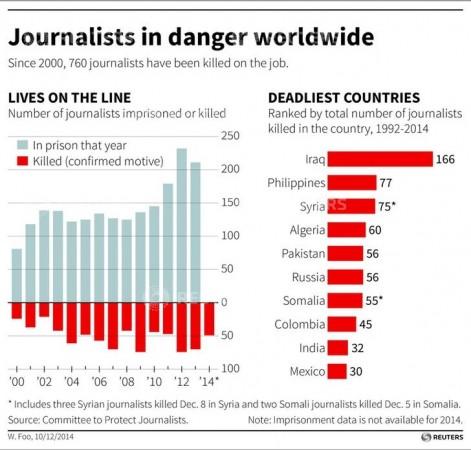The year 2014 has been a bad one for international journalists, with 60 of them killed while performing their duty, many of them in trouble spots that include the Middle East, Ukraine and Afghanistan.
According to the annual review conducted by Committee to Protect Journalists (CPJ), 60 international journalists were killed worldwide, making 2014 the deadliest year for journalists everywhere. Although it is lesser than the 70 deaths reported in 2013, the deaths of 18 more journalists in 2014 are being looked into, to determine if they were work-related as well.
This year's numbers are a direct reflection of the "increasingly volatile nature" of the tension-ridden areas, wherein Westerners are "deliberately targeted", says Shazdeh Omari, who prepared the CPJ report.
The dangers faced by international journalists were brought to attention in April when German-origin reporter Anja Niendringhaus, working with the Associated Press was killed in Afghanistan by a police officer while covering the elections.Later, in August, the execution of journalists James Foley and Steven Sottloff also triggered widespread outrage.
The execution of Foley, who was kidnapped in Syria couple of years back, was captured on video and posted online by the Islamic State (IS). Two weeks later, the video showing the execution of US-Israeli journalist Steven Sottloff, who was kidnapped in August 2013, was also posted online by the IS.
In addition to international journalists losing their lives in combat zones, an overwhelming number of local reporters also face threat. In Syria, for example, around 20 local correspondents have been reported missing, all of whom presumed to be held by the IS.
In fact, Syria has retained its position as the "world's deadliest country for journalists" for the third year in a row.
Another Middle Eastern country facing unrest, Iraq, saw death of five journalists who were covering the clashes between the Iraqi government and its allies against the Islamic State.
Four journalists were killed while covering the 50-day conflict between Israel and the Occupied Palestinian Territories in July and August.
The study shows that almost half of the journalists killed in 2014 died in the Middle East, of which 38 % died in combat or crossfire.
Meanwhile, Reuters has released a chart that depicts the dangers to journalists worldwide. It also shows the break-up of deaths of 760 journalists since 2000.


















